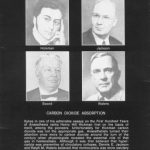The History of Anesthesiology Reprint Series: Part 5 – Carbon Dioxide Absorbtion.
Part Five published in 1975.
Carbon Dioxide Absorption
W. Stanley Sykes, in one of his admirable essays on the First Hundred Years of Anaesthesia, ranks Henry Hill Hickman first on the basis of merit, among the pioneers. Unfortunately for Hickman carbon dioxide was not the appropriate gas. Anaesthetists turned their attention once more to carbon dioxide around the turn of the century when physiologists revealed the essential role of that gas in homeostasis. Although it was first believed that hypercarbia was preventive of circulatory collapse, Dennis E. Jackson and Ralph M. Waters believed that normocarbia was more salutary during anesthesia. Jackson demonstrated the efficacy of carbon dioxide absorption during closed system anaesthesia in the dog while, later on, Waters introduced the technique in man. Brian C. Sword advocated the circle rebreathing system as being more convenient that Waters' to and fro apparatus. Anaesthetists today have lost sight of the advantages of rebreathing: economy, conservation of body heat and water, and avoidance of atmospheric pollution.
Catalog Record: The History of Anesthesiology Reprint Series: Part 5 – Carbon Dioxide Absorbtion.
Access Key: ajvc
Title: The history of anesthesiology reprint series : part five : carbon dioxide absorption.
Author: Hickman, Henry Hill, 1800-1830.
Author: Jackson, Dennis E. (Dennis Emerson), 1878-1980.
Author: Waters, Ralph Milton, 1883-1979.
Author: Sword, Brian C.
Corporate Author: Wood Library-Museum of Anesthesiology.
Call Number: WO 211 M W85 1975
Publisher: Park Ridge, Illinois : Wood Library-Museum of Anesthesiology, ©1975.
Physical Description: 4 parts (in one portfolio) ; 23 cm.
Subject: Carbon Dioxide Absorbers – history.
Subject: Carbon Dioxide – adverse effects.
Subject: Anesthesiology – history.
Subject: Anesthesia – history.
Series Title: The history of anesthesiology reprint series
Series Number: part 5.
Alt. Title: Carbon dioxide absorption.
Alt. Title: Letter on suspended animation, containing experiments shewing that it may be safely employed during operations on animals … / by H. Hickman.
Alt. Title: New method for the production of general analgesia and anaesthesia with a description of the apparatus used / by D. E. Jackson.
Alt. Title: Clinical scope and utility of carbon dioxide filtration in inhalation anesthesia / by R. M. Waters.
Alt. Title: Closed circle method of administration of gas anesthesia / Brian C. Sword.
Content Notes: [1] Letter on suspended animation… / by H. Hickman, 1824 — [2] A new method for the production of general analgesia and anaesthesia with a description of the apparatus used / by D.E. Jackson, 1915 — [3] Clinical scope and utility of carbon dioxide filtration in inhalation anesthesia / by R.M. Waters, 1924 — [4] Closed circle method of administration of gas anesthesia / Brian C. Sword, 1930.
General Note: Cover title.

